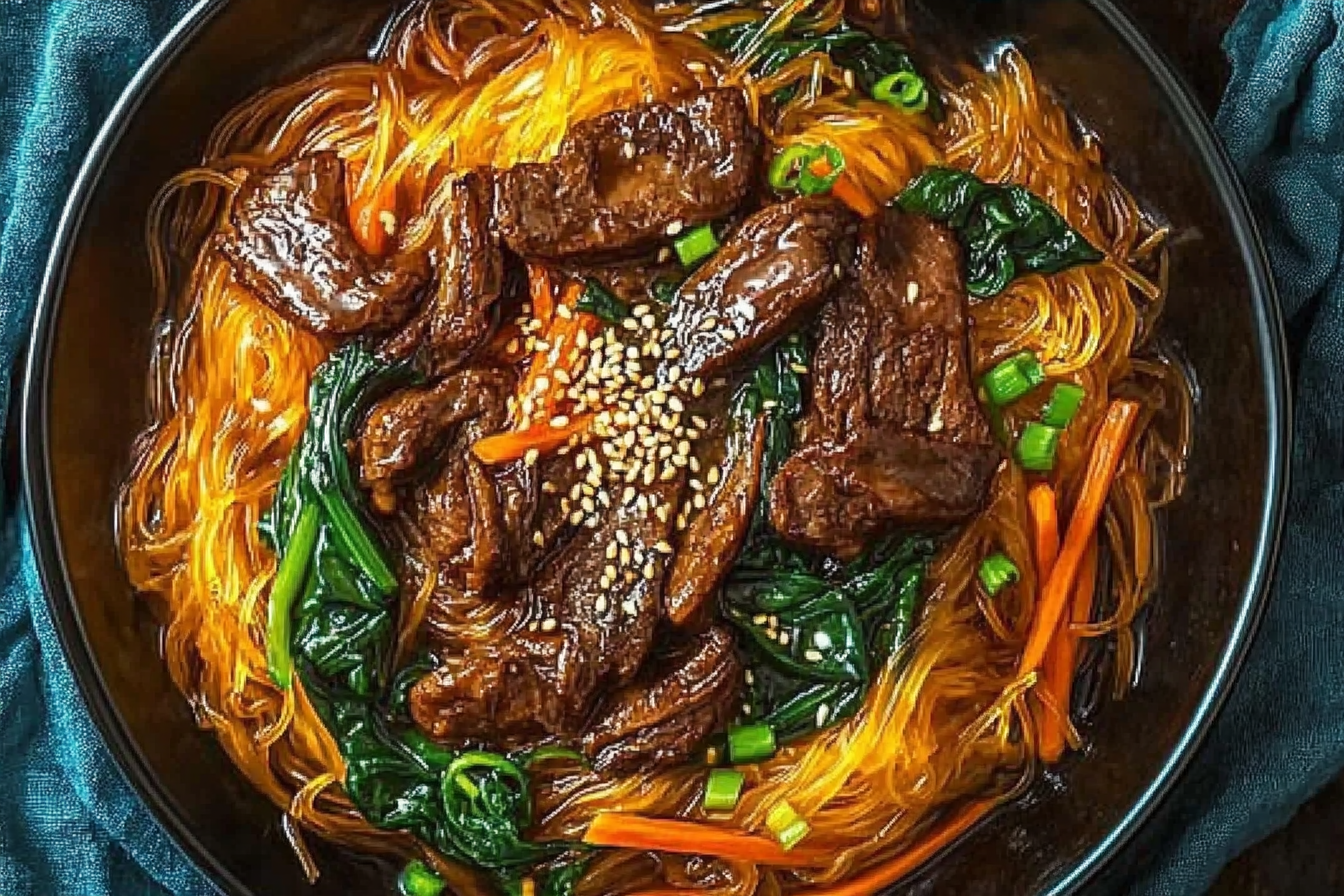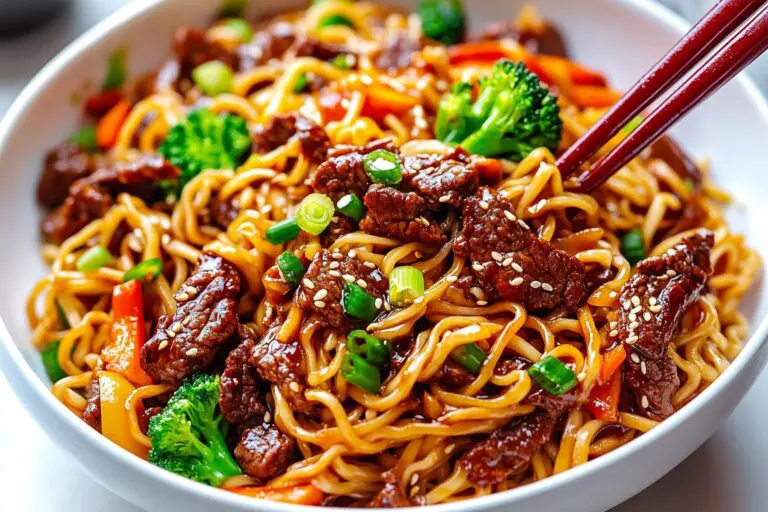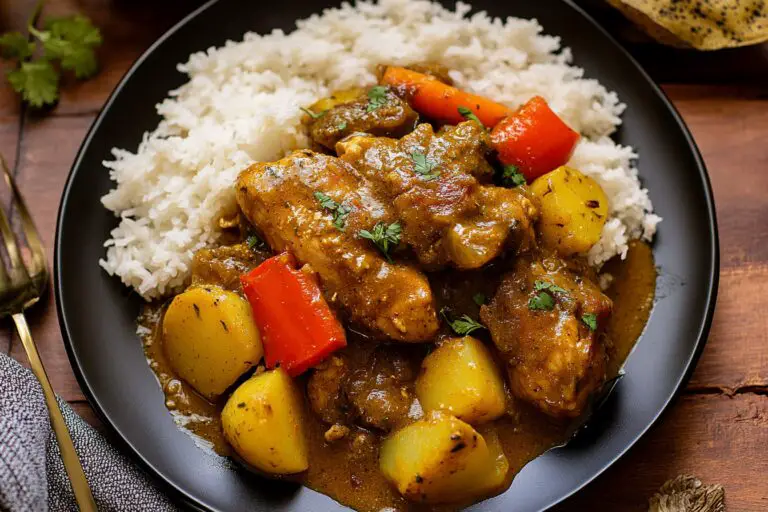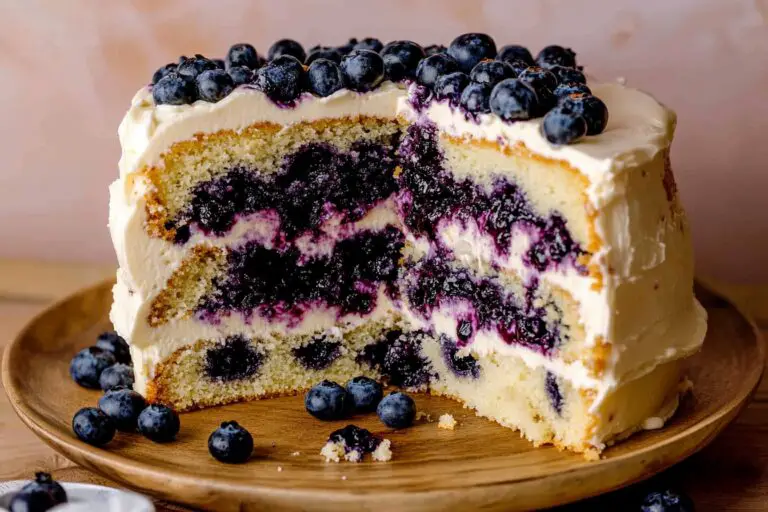Japchae Noodle Stir-Fry
Introduction
Japchae is a traditional Korean dish made from stir-fried sweet potato noodles, known for their unique texture and ability to absorb flavors. This delicious dish combines a medley of vegetables, meat (often beef), and a sweet soy sauce-based seasoning. Japchae is not only a flavorful dish but also offers a colorful presentation, making it a popular choice for celebrations and special occasions.
Detailed Ingredients with measures
Sweet potato noodles: 200 grams
Vegetable oil: 2 tablespoons
Beef (thinly sliced): 150 grams
Carrot (julienned): 1 medium
Spinach: 100 grams
Bell pepper (sliced): 1 medium
Onion (sliced): 1 medium
Garlic (minced): 2 cloves
Soy sauce: 3 tablespoons
Sugar: 1 tablespoon
Sesame oil: 1 tablespoon
Sesame seeds: for garnish
Prep Time
20 minutes
Cook Time, Total Time, Yield
Cook Time: 15 minutes
Total Time: 35 minutes
Yield: Serves 4 people
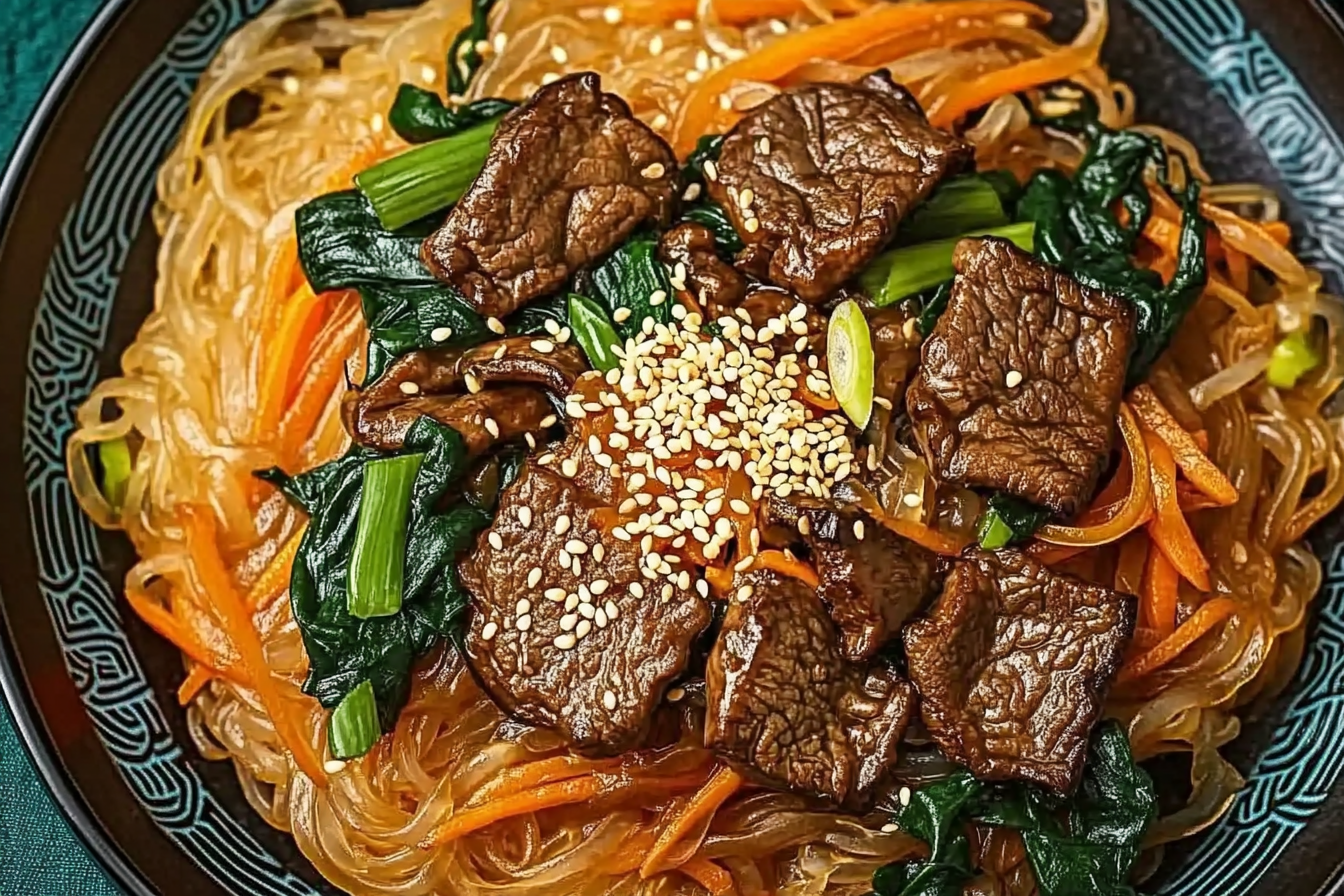
Detailed Directions and Instructions
Step 1: Soak the Noodles
Begin by soaking the sweet potato noodles in hot water for about 30 minutes until they become soft and pliable.
Step 2: Prepare the Vegetables
While the noodles are soaking, prepare the vegetables. Julienne the carrots, slice the mushrooms, and chop the spinach and onion into manageable pieces.
Step 3: Cook the Noodles
Once the noodles have soaked, drain and rinse them. In a pot, bring water to a boil and cook the noodles for about 5-7 minutes until they are fully transparent. Drain and set aside.
Step 4: Stir-Fry the Vegetables
In a large skillet or wok, heat vegetable oil over medium-high heat. Add the onions and stir-fry until they are translucent. Then add the carrots and mushrooms, cooking until tender. Finally, add the spinach and stir until wilted.
Step 5: Combine Noodles and Vegetables
Add the drained noodles to the skillet with the cooked vegetables. Gently mix everything together.
Step 6: Season the Dish
Pour in soy sauce and sesame oil. Toss everything to ensure that the noodles and vegetables are adequately coated. Cook for another few minutes to let the flavors meld.
Step 7: Serve
Transfer the japchae to a serving dish and sprinkle with sesame seeds. Serve warm or at room temperature.
Notes
Note 1: Noodle Variations
Feel free to substitute or add other vegetables such as bell peppers or zucchini according to your preference.
Note 2: Protein Options
You can enhance the dish by adding cooked beef, chicken, or tofu for additional protein.
Note 3: Storage Instructions
Leftover japchae can be stored in an airtight container in the refrigerator for up to 3 days. Reheat gently before serving.
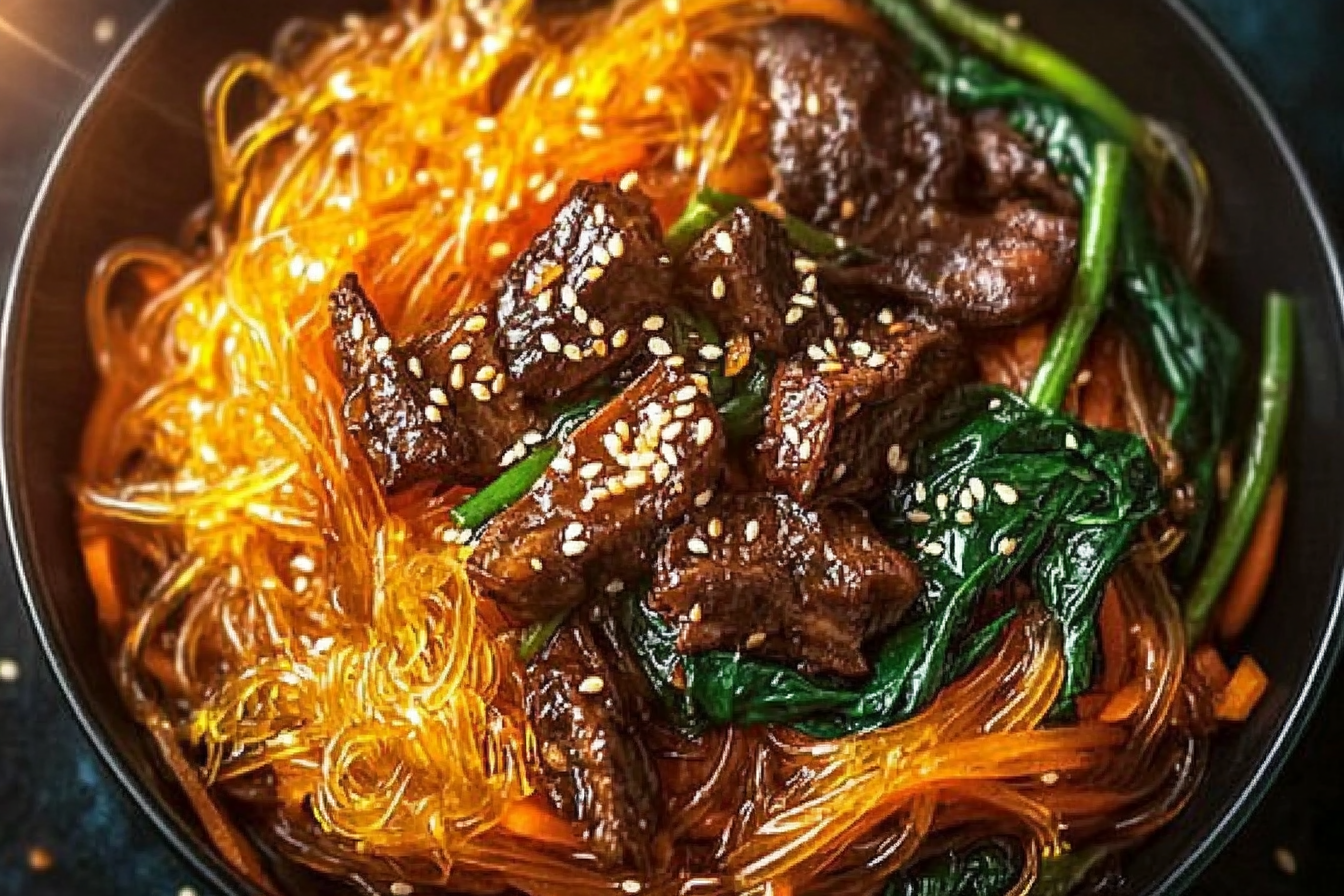
Cook techniques
Preparing Sweet Potato Noodles
Sweet potato noodles, also known as dangmyeon, need to be cooked in boiling water for about 6-7 minutes until they become tender yet chewy. After cooking, rinse them in cold water to halt the cooking process and remove excess starch.
Sautéing Vegetables
Sauté vegetables such as onions, carrots, and bell peppers in sesame oil over medium-high heat. Ensure that the vegetables are cut uniformly for even cooking, and sauté until they’re slightly translucent but still crisp.
Stir-Frying
Combine all sautéed vegetables and cooked noodles in a large skillet or wok. Stir-fry them together, adding soy sauce and sugar to enhance flavor. Maintain high heat and keep stirring to avoid burning.
Seasoning
Adding the right balance of soy sauce, sesame oil, and sugar is key to enhancing the overall flavor profile of japchae. Taste and adjust the seasoning as needed for a perfect blend.
Garnishing
Garnish the finished dish with sesame seeds and sliced green onions for a fresh presentation. This not only adds visual appeal but also brings additional flavor and texture to the dish.
FAQ
Can I use other types of noodles instead of sweet potato noodles?
While sweet potato noodles are traditional, you can substitute them with other stir-fry noodles, but the texture and flavor may differ.
Is japchae gluten-free?
Yes, as long as you use gluten-free soy sauce, japchae can be made gluten-free, since sweet potato noodles are naturally gluten-free.
How can I store leftover japchae?
Leftover japchae can be stored in an airtight container in the refrigerator for up to three days. Reheat in a skillet with a little oil to restore its texture.
What vegetables are best for japchae?
Common vegetables include spinach, carrots, bell peppers, and mushrooms, but you can customize the dish with any vegetables you prefer.
Can I add protein to my japchae?
Absolutely! You can add cooked beef, chicken, shrimp, or tofu to make the dish more filling and nutritious.
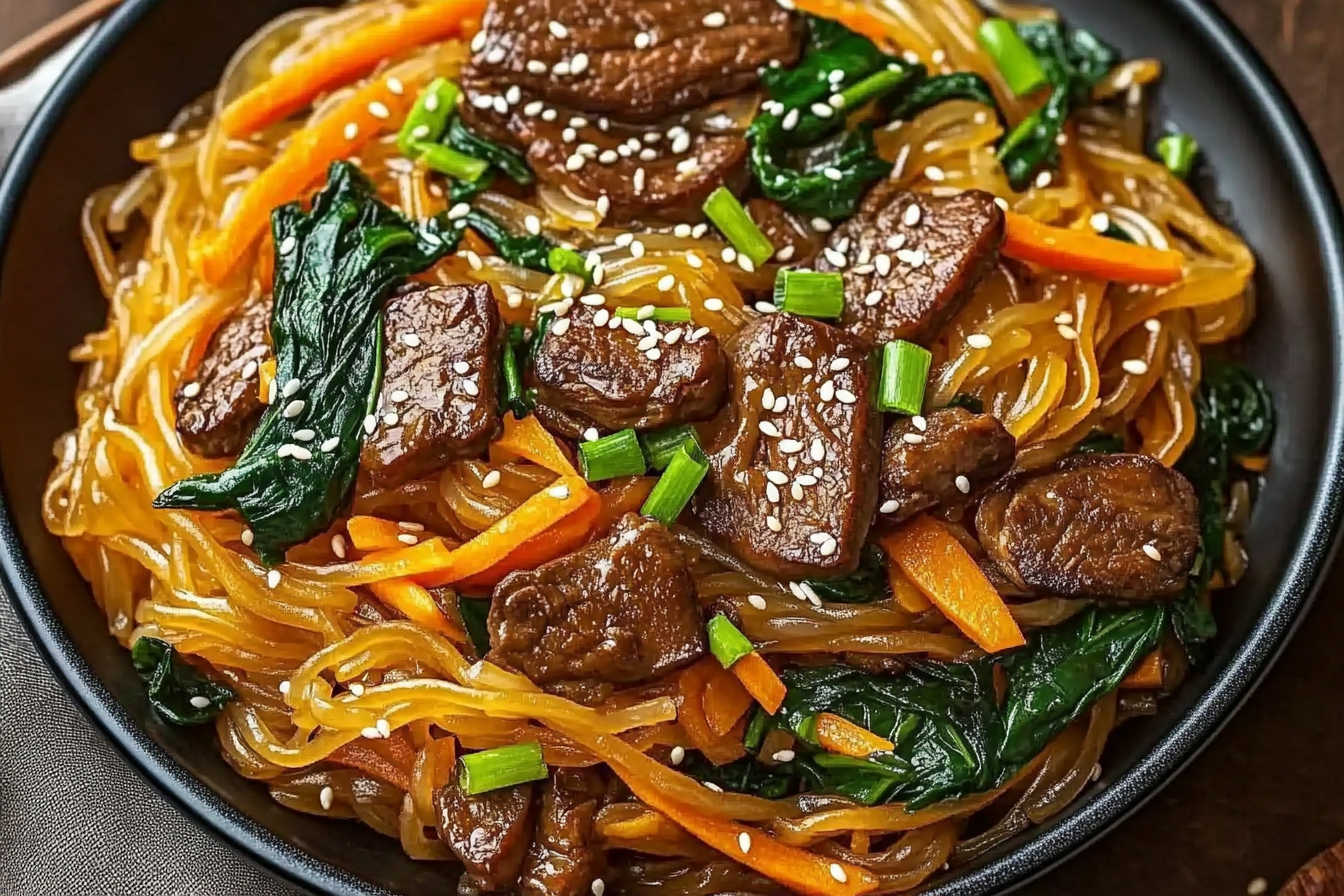
Conclusion
Japchae is a wonderfully versatile dish that beautifully combines flavors and textures. Its adaptability allows for various interpretations, making it a popular choice in both traditional and modern cuisine. Whether enjoyed as a main dish or a side dish, Japchae is sure to impress with its vibrant colors and delicious taste, making it a delightful addition to any meal.
More recipes suggestions and combination
Vegetable Japchae
Enhance the veggie quotient by using a mix of seasonal vegetables such as bell peppers, mushrooms, and spinach for a colorful twist.
Beef Japchae
Add thinly sliced marinated beef for a heartier version of this dish, perfect for meat lovers.
Chicken Japchae
Use shredded chicken in place of beef for a lighter, protein-packed variation.
Seafood Japchae
Incorporate shrimp or scallops for a delightful seafood interpretation of this classic dish.
Korean BBQ-inspired Japchae
Serve Japchae alongside grilled meats to create a fresh and vibrant meal that echoes traditional Korean BBQ.
Vegan Japchae
Substitute all animal products with tofu and a variety of vegetables for a delicious vegan-friendly option.
Spicy Japchae
Spice things up by adding gochujang or chili flakes for a zesty kick that elevates the savory flavors.

